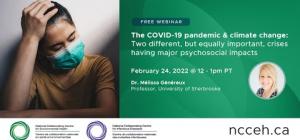
The Omicron wave – communicating during uncertainty

While the emergence of a new variant of concern (VOC) was not unexpected, there is concern about how quickly Omicron is spreading, and how different the Omicron wave may be from previous waves of the COVID-19 pandemic in Canada. Good health communication practice recommends that agencies speak early, often and accurately when health crises emerge. This helps to build trust, reduce anxiety and limit the spread of misinformation. The dynamic nature of the Omicron variant and a sudden shift in the trajectory of the pandemic necessitates a return to public health best practices. Even when much is still unknown, frequent communication is essential, and may require public health professionals to revisit effective communication strategies. Communicating early and clearly about uncertainty can signal to the public that researchers and scientists around the world are working hard to understand Omicron and its impacts. Being clear about what we do know and what we don’t know will be critical to navigating the coming weeks, and helping the public to follow public health guidance and overcome some of the pandemic complacency that has set in.
About Omicron
What we do know is that Omicron contains a larger number of mutations compared with previous VOC, and most of these mutations are associated with the spike protein. We also know that some of these mutations have been observed in other VOC and have been associated with tighter binding of the SARS-CoV-2 virus to target cells, and evading the immune response produced from vaccination or prior infection. What we don’t know fully is how, and to what degree the combination of mutations observed in Omicron is impacting transmissibility, virus detection, disease severity, or vaccine effectiveness.
Transmissibility
What we do know unequivocally is that Omicron spreads much more easily than any other VOC so far. This is evidenced in the rapid rise in case numbers in many countries around the world, with UK data showing an increase in household transmission risk and secondary attack rate compared with the Delta variant. Researchers in Hong Kong have reported that the virus replicates faster in the human bronchus compared with other strains, but less efficiently in human lung tissue than the original strain. What we don’t know with any certainty is the mechanism for increased transmissibility, and how this may impact routes of transmission and the effectiveness of some non-pharmaceutical interventions. We also don’t know how interpersonal variability will influence transmissibility. Further study on the incubation time, the viral load of infectious persons, and the interval between an index case and a secondary case will inform mechanisms of transmissibility.
Virus detection
What we do know is that current test methods used by public health authorities in Canada that are designed to detect multiple genetic targets can detect the Omicron variant. Some test methods based on single targets may fail to detect Omicron if the target area is where deletions of the genome have occurred. The US FDA has published a list of tests expected to fail to detect Omicron. Rapid antigen tests are known to have a range of sensitivity for detecting COVID-19 overall, but initial testing by the UK NHS indicates the level of sensitivity is maintained for Omicron. What we don’t know is how well Omicron infections will be detected in other countries with less access to multiple target tests.
Disease severity
What we do know is that more data on disease progression for Omicron infections is needed to understand its impact on severity. It may take several weeks for rising case numbers to result in a clear change in outcomes. While severe cases and deaths remain low in the EU/EEA, many reported cases are very recent, and are among young people (e.g., 20-49 years of age), who have had better overall outcomes than older populations in previous waves. There is also a higher level of vaccine coverage in the population than in previous waves. In Denmark, early analysis of a small number of Omicron cases found that 1.2% resulted in hospitalization, compared with 1.5% for Delta. In the Guateng province of South Africa, where the Omicron wave began earlier, COVID-19 hospital admissions have increased overall, which may be a product of rapid growth in cases rather than due to increased disease severity. What we don’t know is how generalizable reports on severity will be to various populations, given the wide variation in the demographics, vaccine type and coverage, and implementation and adherence to public health measures. Even if disease caused by Omicron is less severe, the rapid growth in cases may result in rising hospitalizations and deaths nonetheless. We also don’t know how Omicron will impact post-acute COVID-19 syndrome.
Vaccine effectiveness
What we do know is that Omicron harbours a large number of mutations in the regions of the spike protein that are recognized by antibodies. mRNA vaccines recognize more than one part of the spike protein, so a single mutation is unlikely to result in substantially reduced protection. However, the multiple mutations present in Omicron may have a greater impact. Initial data have shown reduced vaccine effectiveness against infection for doubly vaccinated persons, compared with previous strains, although vaccination likely provides protection against severe disease. A better effect against infection is observed for persons who have received a booster dose. What we don’t know is how other aspects of the immune response such as long-lived B cells or memory T cell responses may be contributing to protection, which may not be assessed via in vitro studies. Further data are also needed to assess the level of protection against hospitalization and death for those who have received two and three doses of vaccine.
Reinvigorating COVID-19 messaging
When public officials wait too long to speak about issues that are being debated in the public sphere, a risk communication vacuum can occur. Communication vacuums can negatively impact trust in public health and frustrate precautionary measures. Communicating new information about Omicron provides an opportunity for public agencies to reiterate the strategies that reduce transmission of COVID-19 more generally, even when there is significant uncertainty specific to the Omicron VOC. Social listening tools can also help to identify areas of greatest concern to the public, and provide a means to identify and address misinformation quickly.
There are several opportunities where messaging can be reinforced and updated. It is important to emphasize that infection with the Omicron variant can potentially result in a serious and life-threatening illness for some. The expected surge in cases will undoubtedly lead to a rise in hospitalizations and deaths from COVID-19, particularly among vulnerable and unvaccinated populations. The increase in transmissibility means a susceptible person may be infected more efficiently than before. A surge in cases will put healthcare systems under stress, and divert resources from other healthcare needs. Even if cases are mild, the Omicron wave could lead to a significant level of absenteeism as workers are required to stay home if infected or ill.
While vaccination and booster campaigns must continue, the time delay means that strong actions are needed sooner to slow the Omicron wave. Strengthening measures to reduce transmission will reduce infections and help to flatten a potentially exponential curve. Increased transmissibility of the Omicron variant implies that risks from all routes of transmission may be heightened. The key messages to reinforce include:
- Reducing contacts - Avoiding exposure helps to avoid infection. Reducing exposure can be done through changing individual behaviors, keeping gatherings small, discouraging unnecessary travel, returning to working from home where possible, and reducing time in crowded public spaces.
- Keep masking - Using the best quality mask available when in public is more important now than ever. A well fitted N95 respirator provides the best protection when available. Ensure that masks fit well and consider double masking where a respirator is unavailable to protect the wearer and others.
- Don’t share air – Transmission occurs easily indoors in crowded or poorly ventilated spaces. Reducing the amount of “shared-air” is key. This is achieved by choosing ventilated spaces, opening windows, using extractor fans to remove indoor air, and where appropriate, using an air cleaning device. Well ventilated space should be chosen over others, but even outdoor gatherings should be avoided if crowded.
- Keep clean – Reducing the amount of viable virus an individual is exposed can be achieved by continuing to keep surfaces and hands clean, and avoiding contact with eyes, nose and mouth with unwashed hands. While fomites have been discounted as a significant route of transmission for previous strains, any reduction in exposure for a highly transmissible variant may be important.
- Think of others – Encouraging individuals to stay away from others when ill or feeling any symptoms can reduce exposures, as can the use of rapid tests (where appropriate, and available) and continuing to observe respiratory etiquette and appropriate mask use.
There is a need to continue to apply public health measures that reduce transmission by the known routes, with layering of measures and pre-emptive strategies to reduce transmission. Public health communicators need to circle back to best practice recommendations and re-engage with the public. This may require increasing the frequency of communications and outreach and providing information quickly to ensure that people are aware that the trajectory of the pandemic may shift.
Further resources on communications during a health crisis can be found here:
- Lesson from COVID-19 on executing communications and engagement at the community level during a health crisis (Overton et al., Dec 2021)
- Toward effective government communication strategies in the era of COVID-19 (Hyland-Wood et al. 2021)
- Effective communication strategies for COVID-19 (Ontario Health Association, 2020)






